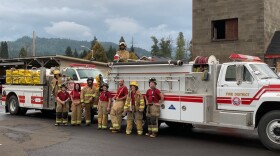-
Ashland is finalizing a plan that will hopefully make the city a climate refuge in the era of massive wildfires. It’s the first update in more than 20 years.
-
Oregon lawmakers have voted to repeal the state’s contentious wildfire hazard map, which subjected homeowners in certain areas at high risk of wildfires to stricter building codes and requirements to reduce vegetation on their properties.
-
Three proposals to boost wildfire funding this session have died though one bill, to protect wildfire survivor settlements, is on its way to Gov. Kotek.
-
The federal government has allocated $38 million in wildfire funding to three areas of high risk in Oregon.
-
In a wildfire, overgrown brush can be the tinder that threatens a nearby home. Now, an Oregon nonprofit is offering to help property owners reduce their risk by clearing it away.
-
As the cost of fighting wildfires increases, state Sen. Elizabeth Steiner has proposed a bill — developed in consultation with the logging industry — that would shift millions in expenses away from the biggest landowners and onto taxpayers.
-
Row River Valley residents have petitioned to create their own rural fire district. They say depending on fire districts in other communities leaves them vulnerable to wildfire.
-
About 16 million people in California will see their electric and gas bills go up by an average of more than $32 per month over next year in part so that one of the nation's largest utility companies can bury more of its power lines to reduce the chances of starting wildfires
-
A new study from UC Davis researchers found that the proportion of good to bad fire in the Sierra Nevada — and much of California — is out of balance.
-
The federal government announced a $930 million investment last week that would go toward 11 at-risk areas located throughout the western U.S., in an effort to aid regions hard hit by wildfires. The at-risk areas include parts of California, Oregon, Arizona and eight other states.
-
Ashland Fire and Rescue is in need of more volunteers to help with a backlog of home evaluations for wildfire risk.
-
Intentional, low-severity fires are a key tool in managing forests to reduce wildfire risk. Rare but high-profile escapes can hamper efforts to light more of them.
-
William Simpson wants to deploy the wild horses across public lands, to live and graze — and ultimately, prevent the worst wildfires.
-
After withdrawing a controversial map of wildfire risk on every property statewide, the Oregon Department of Forestry is planning to spend the next year talking with the public and revising the map.















